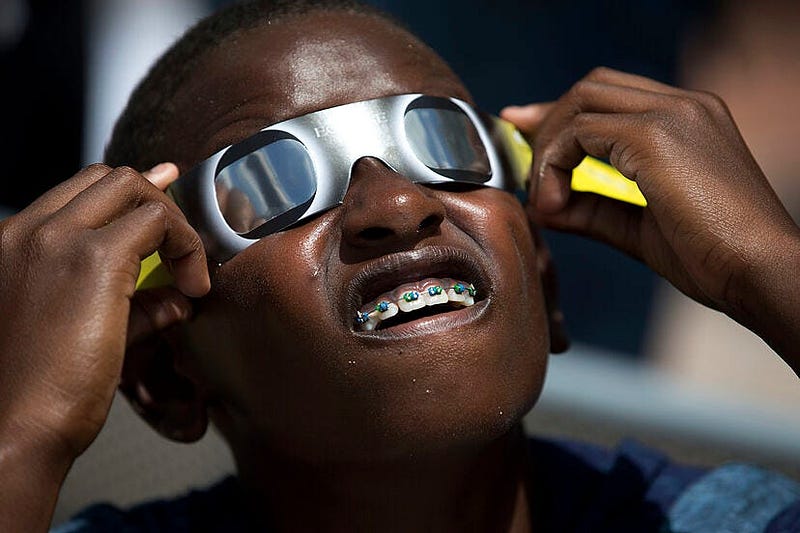Exploring the Intersection of Religion and Science During the Eclipse
Written on
The Eclipse and Its Multidimensional Impact
The upcoming Total Solar Eclipse on April 8, 2024, has prompted collaboration between scholars of religion and optometrists, as they prepare for this monumental event. This eclipse will trace a path from southwest Mexico, through east Texas, and extend across cities like Fort Worth, Bloomington, Indianapolis, Cleveland, and upstate New York.
Many historians and religious scholars believe this celestial occurrence could herald significant changes that some may find hard to accept. This article will explore three essential facets of humanity: the eyes, the heart, and the soul. While the implications of eclipses can be analyzed post-event, residents of Indiana will have a unique opportunity to witness the eclipse firsthand, potentially altering their worldview.
The Spiritual Significance of the Eclipse
Religious historians have noted that the eclipse's trajectory will intersect with eight cities named Nineveh and Salem throughout the Midwest and deep South. According to Eclipse 2024 dot org, Nineveh’s path will encompass areas in Missouri, Indiana, Kentucky, Ohio, Virginia, West Virginia, and upstate New York. Conversely, the towns named Salem will be found in Arkansas, Illinois, Indiana, Ohio, Nebraska, Kentucky, and Maine.
This trajectory represents a marked difference from the 2017 eclipse, which primarily impacted towns in Oregon, Nebraska, Kentucky, Tennessee, and South Carolina. Additional towns such as Rapture, Indiana, and Jonah, Texas, are also on the eclipse's path, prompting scholars to ponder the religious implications of this event.
Skeptics and experts have taken to platforms like TikTok and YouTube to discuss these phenomena, with social media accounts such as “Navigating the Lies” referencing biblical tales. They highlight the story of Nineveh, which allegedly had “40 days to repent or face judgment from God.” These discussions suggest that the eclipse could serve as a divine sign, instigating a spiritual awakening or rapture that might alter our lives amid societal corruption.
The validity of such predictions remains speculative. Father Kurt Messick, an Astronomy Associate Professor at Ivy Tech Community College in Bloomington, finds these interpretations intriguing, despite his limited knowledge of the eclipse.
Brandon Barker, an Assistant Professor at the IU Department of Folklore and Ethnomusicology, discussed folklore and skepticism at a solar eclipse workshop held on Zoom in November 2023. He emphasized that humans have historically crafted narratives around eclipses, reflecting a unique capacity to seek explanations and meaning.
The Role of Vision in the Eclipse Experience
The eyes play a crucial role in our safety and emotional response during the eclipse. Safety precautions, such as wearing protective glasses, are vital when the moon obscures the sun. Dr. Hin Cheung, an optometrist at the Atwater Eye Care Center affiliated with IU’s School of Optometry, has organized community workshops to educate the public on eye safety during the eclipse.
Reports from the IDS have focused on proper eyewear use during the event, while the philosophical implications have also been discussed. Cheung and his team have dedicated the past year to outreach initiatives, emphasizing the importance of eye protection while also exploring the deeper meanings of the eclipse experience.
The Denver Post noted that during the 2017 eclipse, many viewers reported seeing celestial bodies far beyond our solar system. In Carbondale, Illinois, which will also be a viewing point in 2024, children were captivated by the sights they observed once they removed their glasses, showcasing the innate human curiosity and wonder.
The Historical Context of Death and the Eclipse
The connection between eclipses and death carries fascinating historical weight. The religious implications of these events can offer a form of holy intervention, impacting the soul and bodily suffering. Notably, on May 10, 1994, the execution of serial killer John Wayne Gacy coincided with an annular solar eclipse that spanned from Mexico to northern Indiana. Concurrently, Jeffery Dahmer was baptized, providing a dual narrative of redemption and judgment.
The concept of karma interplaying with good and evil is echoed in the stories of historical figures like King Henry I and King Mongkut. The National Air and Space Museum notes that King Henry I died during a solar eclipse, prompting historian William of Malmesbury to remark on the “hideous darkness” that unsettled the populace. King Mongkut's demise was also linked to a solar eclipse, suggesting that celestial events may be intertwined with significant life changes.
Conclusion: A New Perspective on Eclipse Narratives
In summary, the eclipse offers a rich tapestry of narratives that intertwine religion and astronomy. As we anticipate this celestial event, the exploration of its implications can contribute to our understanding of human thought and spirituality.
The first video titled "As Far As The Eye Can See" delves into how the solar eclipse has prompted discussions among scholars and optometrists regarding its meaning and significance.
The second video, "Waylon Jennings..... As Far as The Eye Can See," further explores the historical context and cultural narratives surrounding eclipses, enhancing our understanding of this remarkable phenomenon.
